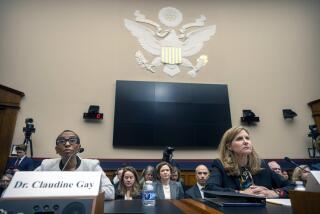Op-Ed: Liberals and conservatives both misuse facts. But there are ways to stop that impulse

The White House is reportedly considering expanding its restrictions on travel to the United States from majority-Muslim countries. Amid heightened tensions with Iran, there was increased scrutiny of Iranian Americans returning to the U.S. from Canada. And the governor of Texas recently closed his state to refugee resettlement, citing security concerns.
Most Republicans have supported restrictive policies such as the so-called Muslim travel ban, and most Democrats have opposed them. Policies that affect hundreds of thousands of people should be guided by facts, not political partisanship. But even when liberals and conservatives agree about what the facts are, they disagree about which facts are relevant.
In a recent study, we provided people with a few simple statistics and asked them which was most important to consider in evaluating several policies, including the Trump administration’s 2017 travel ban. Most supporters of the ban reported that the most important statistic was that 70% of immigrants who are identified as terrorists are from predominantly Muslim countries. But this statistic implies that Muslim immigrants pose a misleadingly high threat — and those who opposed the ban easily saw through the faulty reasoning.
To appreciate the problem, consider a less polarizing example. About 75% of NBA players are black but only about 0.002% of black men play in the NBA. So, it would be senseless to look at all black men in America when scouting NBA talent. Yet that is exactly the logic used when citing the fraction of terrorists who are Muslim to gauge the threat of Muslim immigrants.
Most of us have difficulty thinking clearly about “conditional probabilities” — the likelihood of an event occurring given that some other event has already occurred. The likelihood that immigrants who have been identified as terrorists are from Muslim countries is a conditional probability. But it’s not especially informative about the terrorist threat posed by Muslim immigrants — just as it’s not especially informative that 75% of NBA players are black.
The more important probability is the inverse: the fraction of immigrants who are terrorists given that they are from Muslim countries. Because terrorism is so rare, this statistic is vastly smaller. Only about 0.00004% of Muslim immigrants are terrorists. Opponents of the Muslim travel ban correctly recognized that this minuscule number was more relevant to assessing the terrorist threat.
Misusing probabilities to justify restrictions on immigrants and refugees is not limited to the U.S. In a study conducted in Israel, we asked people to consider statistics regarding a policy to reduce crime by expelling Eritrean and Sudanese asylum seekers from South Tel Aviv, Israel.
Those on the right supported the expulsion and thought the most important statistic they read was that about 200 of 360 residents of Tel Aviv who committed crimes were also asylum seekers. Leftists opposed the expulsion and thought the most important statistic was that only 200 of 20,000 asylum seekers committed crimes. Israelis on different ends of the political spectrum were sharply divided about which facts were relevant.
Liberals are not necessarily more clear-headed than conservatives when it comes to statistics. In our study, liberals were equally willing to cite misleadingly high statistics when considering a different policy: banning people from owning assault weapons to combat mass shootings.
Most supporters of an assault weapons ban thought the most important statistic that we presented was that nearly 70% of Americans who committed mass shootings (which killed four or more people other than the shooter) owned an assault weapon.
Opponents of the assault weapons ban readily identified that the more important statistic is the inverse: the fraction of assault weapons owners who committed mass shootings. Only 0.00003% of the 12 million Americans who owned an assault weapon committed a mass shooting in the past seven years. When the ideological tables were turned, liberals embraced the same type of misleadingly high statistic and conservatives recognized the faulty reasoning.
Policy evaluations are not only guided by statistics, of course. Different choices might reflect different values. Is it a worthwhile trade-off to reduce the very rare frequency of terrorism, mass shootings, and other violent crimes by shutting down Muslim immigration, restricting the ability to purchase assault weapons and expelling refugees? Our studies suggest that rather than confront the trade-offs, people rely on misleading statistics when choosing to support these policies.
But our studies also show that people can change their understanding of rare events. We asked them to try to think like an expert policy analyst. One might fear that their policy choices would still be driven by their ideological stances. But that’s not what happened.
For all three policies, this simple instruction reduced differences in the information that liberals and conservatives deemed important. It increased the number of people on both sides who thought the most important statistics were the fractions of Muslim immigrants who were terrorists, weapons owners who were mass shooters, and refugees who were criminals.
These findings suggest that people can be dissuaded from relying on misleading statistics, even against their ideological inclinations. That’s a first step toward adopting thoughtful, effective policies in any sphere.
Leaf Van Boven is a professor of psychology at the University of Colorado Boulder. Ronit Montal-Rosenberg is a postdoctoral fellow at Tel Aviv University. David Sherman is a professor of psychology at UC Santa Barbara.
More to Read
A cure for the common opinion
Get thought-provoking perspectives with our weekly newsletter.
You may occasionally receive promotional content from the Los Angeles Times.






